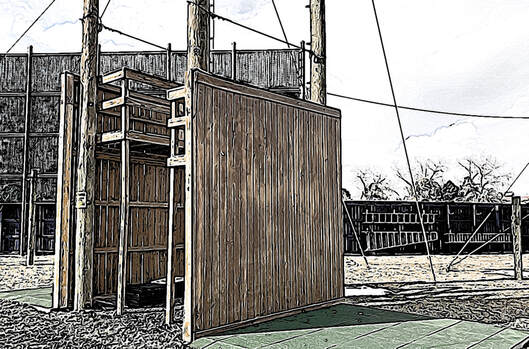|
The Team Wall
The Team Wall 'element' is among the oldest challenges in the history of Ropes/Challenge Courses. Dig back into the early days of Outward Bound in the United States, you'll find the Team Wall as part of the team building that took place before going 'out' on trips. Other historical records show the 'Wall' was repurposed into a team challenge from military obstacle courses of old. Today, Team Walls still stand among a wide range of opinion - "Why are we still using the Wall? What purpose does it have on a course? Is it worth it?"
Is the Wall a low element or a high element? What learning/lessons can we enhance by using the element? Are these learnings worth the risk (perceived and actual)? Should we belay the element or not? Does the element bring a team together or actually separate them? These and other questions about the Wall are commonplace. Where do you stand?
One Educator's (Practitioners) Opinion
I (Chris Cavert) started my career (PA Trained) using the 12-foot Team Wall with no belay. Proper training for spotting was always important - especially watching out for the 'windshield wiper' falls at the sides. What I learned was:
When I became a course manager I learned more about 'best practices' (who remembers the 'Red' booklet?). It came to my attention that there was a limit to where a participant should be above the ground (was this their head, torso, feet - wasn't clear as I recall, and I remember 42 inches??) - basically, if the torso went above the hands of the shortest spotter, the climber should have a harness on and a belay system attached. However, at the time, the Team Wall was the exception.
Then, Ropes/Challenge Course builders began to mitigate the risk - they started building Team Walls with belay systems (shown in the picture above). I saw Walls that were belayed from the ground and some belayed from the top through a GriGri hanging off the belay cable - a facilitator took out the slack in the rope and let the GriGri do the rest.
I liked (still do) the idea of the belay, but I wondered, as I saw these belayed Walls being used, did it change the activity - was it now 'too safe' as the argument about adventure education becoming too safe blossomed. And, looking back, I never witnessed a major 'fall' at this element only major bruises and scrapes getting over the top. Was (is) the element worth it?
Around the time of the new operational dualism - belay or not to belay (that is the questions), which still exists at the time of this writing, I stopped programming the Team Wall. I found many other ways to build team success. However, I still, on occasion, work for course manages who program the Team Wall for clients. If I am contracted to run the Wall, here's how I manage it (cleared by the course manager):
Where do you position yourself around the Team Wall? What are your learning outcomes if you use the Wall? What does the Team Wall do for you that other elements cannot?
Leave us a Comment so we can learn and grow together. Be well... Chris Cavert, Ed.D.
Would you like a (super) quick email notification when new OTB content (blog post or podcast episode) is available? Fill out the form below and we'll let you know.
0 Comments
Your comment will be posted after it is approved.
Leave a Reply. |
OnTeamBuilding is a forum for like-minded people to share ideas and experiences related to team building. FREE Team Building
Activity Resources OTB FacilitatorDr. Chris Cavert is an educator, author and trainer. His passion is helping team builders learn and grow. Archives
January 2024
|



 RSS Feed
RSS Feed